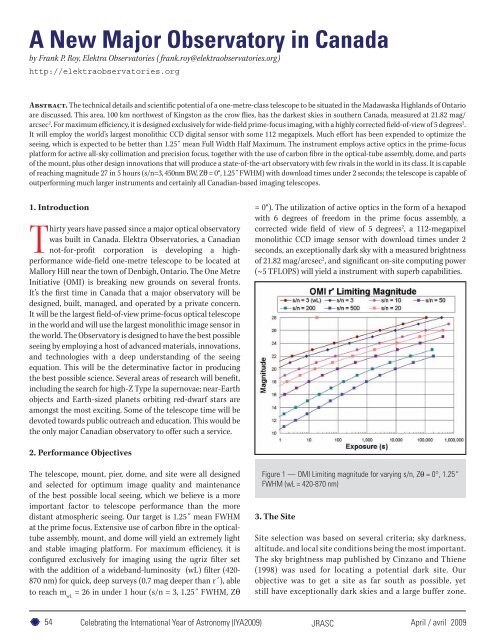Moment
insidethisissue - The Royal Astronomical Society of Canada
insidethisissue - The Royal Astronomical Society of Canada
You also want an ePaper? Increase the reach of your titles
YUMPU automatically turns print PDFs into web optimized ePapers that Google loves.
A New Major Observatory in Canadaby Frank P. Roy, Elektra Observatories (frank.roy@elektraobservatories.org)http://elektraobservatories.orgAbstract. The technical details and scientific potential of a one-metre-class telescope to be situated in the Madawaska Highlands of Ontarioare discussed. This area, 100 km northwest of Kingston as the crow flies, has the darkest skies in southern Canada, measured at 21.82 mag/arcsec 2 . For maximum efficiency, it is designed exclusively for wide-field prime-focus imaging, with a highly corrected field-of-view of 5 degrees 2 .It will employ the world’s largest monolithic CCD digital sensor with some 112 megapixels. Much effort has been expended to optimize theseeing, which is expected to be better than 1.25˝ mean Full Width Half Maximum. The instrument employs active optics in the prime-focusplatform for active all-sky collimation and precision focus, together with the use of carbon fibre in the optical-tube assembly, dome, and partsof the mount, plus other design innovations that will produce a state-of-the-art observatory with few rivals in the world in its class. It is capableof reaching magnitude 27 in 5 hours (s/n=3, 450nm BW, Zθ = 0°, 1.25˝ FWHM) with download times under 2 seconds; the telescope is capable ofoutperforming much larger instruments and certainly all Canadian-based imaging telescopes.1. IntroductionThirty years have passed since a major optical observatorywas built in Canada. Elektra Observatories, a Canadiannot-for-profit corporation is developing a highperformancewide-field one-metre telescope to be located atMallory Hill near the town of Denbigh, Ontario. The One MetreInitiative (OMI) is breaking new grounds on several fronts.It’s the first time in Canada that a major observatory will bedesigned, built, managed, and operated by a private concern.It will be the largest field-of-view prime-focus optical telescopein the world and will use the largest monolithic image sensor inthe world. The Observatory is designed to have the best possibleseeing by employing a host of advanced materials, innovations,and technologies with a deep understanding of the seeingequation. This will be the determinative factor in producingthe best possible science. Several areas of research will benefit,including the search for high-Z Type Ia supernovae; near-Earthobjects and Earth-sized planets orbiting red-dwarf stars areamongst the most exciting. Some of the telescope time will bedevoted towards public outreach and education. This would bethe only major Canadian observatory to offer such a service.= 0°). The utilization of active optics in the form of a hexapodwith 6 degrees of freedom in the prime focus assembly, acorrected wide field of view of 5 degrees 2 , a 112-megapixelmonolithic CCD image sensor with download times under 2seconds, an exceptionally dark sky with a measured brightnessof 21.82 mag/arcsec 2 , and significant on-site computing power(~5 TFLOPS) will yield a instrument with superb capabilities.2. Performance ObjectivesThe telescope, mount, pier, dome, and site were all designedand selected for optimum image quality and maintenanceof the best possible local seeing, which we believe is a moreimportant factor to telescope performance than the moredistant atmospheric seeing. Our target is 1.25˝ mean FWHMat the prime focus. Extensive use of carbon fibre in the opticaltubeassembly, mount, and dome will yield an extremely lightand stable imaging platform. For maximum efficiency, it isconfigured exclusively for imaging using the ugriz filter setwith the addition of a wideband-luminosity (wL) filter (420-870 nm) for quick, deep surveys (0.7 mag deeper than r´), ableto reach m wL= 26 in under 1 hour (s/n = 3, 1.25˝ FWHM, ZθFigure 1 — OMI Limiting magnitude for varying s/n, Zθ = 0°, 1.25˝FWHM (wL = 420-870 nm)3. The SiteSite selection was based on several criteria; sky darkness,altitude, and local site conditions being the most important.The sky brightness map published by Cinzano and Thiene(1998) was used for locating a potential dark site. Ourobjective was to get a site as far south as possible, yetstill have exceptionally dark skies and a large buffer zone.54 Celebrating the International Year of Astronomy (IYA2009)JRASC April / avril 2009
















